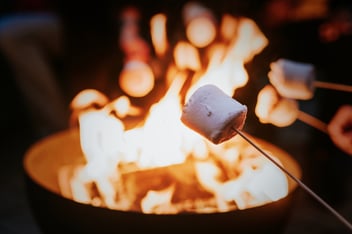%20Camping%20fire%20safety%20-%20blog%20refresh%20-%20FBIG%201x1%20%20(1)-1.png?width=325&height=235&name=Certasite%20-%20September%202024%20-%20(Blog)%20Camping%20fire%20safety%20-%20blog%20refresh%20-%20FBIG%201x1%20%20(1)-1.png)
The fall season brings changing leaves, cooler daytime temperatures and chilly nights – conditions ideal for a camping trip.
Camping is a fun hobby for many individuals, with a campfire forming the heart of the campsite. Campfires keep you warm and provide a place to cook and gather with others. However, campfires can also pose a fire risk.
It’s important to honor these fire risks in order to keep everyone safe and avoid wildfires. In this blog, we’re sharing some top tips to make sure your camping trip stays fire safe, from start to finish.
Choose a safe spot for your campfire
One of the most important parts of keeping a campfire safe is choosing the right location for your fire – and making sure that a fire is allowed in your campsite area at all. In dryer weather, there can be burn bans in effect that prohibit fires during certain times. Always check local ordinances before you start a fire.
After you’ve established that a campfire is allowed, check to see if your area has an existing fire ring or pit. If there is, this is the safest spot to set your fire, assuming it’s at least 10 feet away from anything flammable.
If there’s not, you’ll need to establish a new spot for a campfire. Select a site that’s at least 10 feet away from anything flammable, including tents, shrubs, trees, and other materials. This includes overhanging branches or other debris that would be over top of a fire.
Select an open, level location, and pick a spot away from brush, decaying leaves and logs. Pay attention to the wind; whichever way the wind is blowing, your sparks will blow that way, too.
If no pit exists, you’ll need to dig one. A campfire pit should be about one foot deep, then ringed with rocks for added protection.
Preparing and igniting the fire
Once you’ve identified or created a firepit, the next step is to build the fire itself.
First, make sure you have a water source, bucket and shovel near you at all times, just in case. Next, gather tinder, kindling and fuel (larger pieces of wood) for your fire. Build your fire in the best style for your use – teepee or lean-to for cooking, crisscross or log-cabin for long-lasting – and then light it with a match or lighter. Continue to build the fire until it’s a size that suits your needs, but also small enough for you to maintain control of it at all times.
Maintaining a campfire
One very important rule of a burning campfire is to never put anything into the fire other than wood. Glass, cans, or pressurized containers are especially dangerous, as they can explode and injure you or start a wildfire.
As the fire starts to dwindle, you’ll want to feed it more fuel as needed. However, don’t let the fire get too large – the bigger the fire, the harder it is to keep under control. Regardless of the size of the fire, keep your bucket of water nearby in case you suddenly need it. If water is not available, you can use dirt or sand – just keep a shovel handy.
If you have kids or pets with you, always keep them at least three feet away from the fire for their own safety. This includes cooking activities such as roasting marshmallows; it’s best to have a grown up do this for small children.
And, of course, never leave the fire unattended.
Extinguishing a campfire
Once you’re ready to put the fire out, you should pour lots of water on the fire if you have it available, and pour until the hissing stops. If you do not have a water source, you can instead stir dirt or sand into the embers to bury the fire completely. Any unburnt branches should be scraped with a shovel to remove any additional embers, and those stirred in our doused until none are still smoldering.
Before you leave, all ashes need to be completely cool to the touch. Until that time, the fire is still a hazard and should not be left behind.
At CertaSite, fire and life safety is our passion, both for individuals and organizations. We know it can be overwhelming, and so we’re here to help. Explore tons of critical fire and life safety topics in our blog, or set up a consultation with us to find the best fire and life safety solutions for your business’s unique needs.

